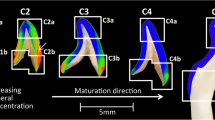Abstract
In the electron microscope, a repeating pattern of minute striations has been observed within hydroxapatite crystals. This fringe pattern can be explained as projections of planes of atoms or molecules on the image plane with a periodicity equal to the spacing between these planes in the crystal lattice. Previous studies have reported a pattern of 8.2 Å repeat periods in hexagonal crystals of young rat enamel, representing the resolution of the 100 planes of the hydroxyapatite crystal lattice. In the present study, fringe patterns were demonstrated in crystals of human enamel, dentin, cementum, and bone tissue. When the incident electron beam was parallel to thec axis, the three sets of equivalent lattice planes parallel to this axis could be resolved simultaneously. Even those crystals which had an unusual external form showed a substructure that consisted of arrays of straight lines. Defects of the fringe pattern indicating dislocations or stacking faults in the crystal lattice were occasionally observed, in particular near the midline of the crystals. Thus, it appears possible to demonstrate visually not only variations in crystal size and shape but also the presence of lattice defects within individual apatite crystals. By high resolution electron microscopy it may prove possible to correlate the crystallinity of bone and tooth apatites to the fine structure of these tissues in normal and pathological conditions.
Résumé
Une structure périodique, formée de fines striations, a pu être observée au niveau des cristaux d'apatite sous le microscope électronique. Ces strations peuvent s'expliquer comme des projections de plans d'atomes ou de molécules sur le plan image, dont la périodicité est égale à la distance entre ces plans dans la maille cristalline. Des études antérieures indiquent une périodicité de 8.2 Å au niveau de cristaux hexagonaux d'émail de jeunes rats, constituée par la résolution des plans 100 de la maille cristalline de l'apatite. Au cours de cette étude, des striations ont pu être mises en évidence au niveau de l'émail, de la dentine, du cément et de l'os humain. Lorsque le faisceau incident d'électrons est parallèle à l'axe c, les trois types de plans équivalents, parallèles à cet axe, peuvent être mis en évidence simultanément. Même les cristaux de forme externe inhabituelle présentent une ultrastructure comportant une série de lignes droites. Des altérations dans les striations, indiquant une disloocation on un défaut d'alignement dans la maille cristalline, sont parfois notées en particulier près de la ligne médiane des cristaux. Des variations de taille et de forme des cristaux et des défauts de maille cristalline ont pu être démontrés au niveau de cristaux individuels. La cristallinité des apatites d'os et de dents peut être liée à l'ultrastructure des tissues normaux et pathologiques.
Zusammenfassung
Im Elektronenmikroskop wird ein sich wiederholendes Muster von winzigen Furchungen innerhalb von Hydroxyapatitkristallen beobachtet. Dieses Randmuster läßt sich als Projektionen von Atom- oder Molekülebenen auf die Bildebene erklären, wobei die Periodizität derjenigen der Abstände zwischen diesen Ebenen im Kristallgitter entspricht. Frühere Untersuchungen ergaben ein Muster mit einer Periodizität von 8.2 Å in hexagonalen Kristallen vom Schmelz junger Ratten; dies stellt die Zerlegung in die 100 Ebenen des Hydroxyapatitkristallgitters dar. In der vorliegenden Untersuchung wurden in Kristallen von menschlichem Schmelz, Dentin, Zement und Knochengewebe Randmuster nachgewiesen. Wenn der einfallende Elektronenstrahl parallel zurc-Achse ist, können die 3 Gruppen von gleichwertigen Gitterebenen, welche parallel zu dieser Achse liegen, gleichzeitig zerlegt werden. Sogar Kristalle mit ungewöhnlicher äußerer Form zeigen eine Substruktur, welche aus Anordnungen von geraden Linien besteht. Defekte im Randmuster, welche Verschiebungen oder Aufbaufehler im Kristallgitter andeuteten, wurden gelegentlich beobachtet, vor allem gegen die Mittellinie der Kristalle. Variationen in der Kristallgröße und-form und das Vorkommen von Gitterdefekten innerhalb einzelner Apatitkristalle, konnten gezeigt werden. Die Kristallinität von Knochen- und Zahnapatiten steht in einer Wechselbeziehung zur feinen Struktur der Gewebe unter normalen und pathologischen Bedingungen.
Similar content being viewed by others
References
Amer. Soc. Testing Materials: X-ray powder diffraction file, card No. 9-432, Philadelphia 1967.
Eanes, E. D., Zipkin, I., Harper, R. A., Posner, A. S.: Small-angle X-ray diffraction analysis of the effect of fluoride on human bone apatite. Archs. oral Biol.10, 161–173 (1965).
Hirsch, P. B., Howie, A., Nicholson, R. B., Pashley, D. W., Whelan, M. J.: Electron microscopy of thin crystals. London: Butterworths 1965.
Nylen, M. U., Eanes, E. D., Ommell, K.-Å.: Crystal growth in rat enamel. J. Cell Biol.18, 109–123 (1963).
—, Omnell, K.-Å.: The relationship between the apatite crystals and the organic matrix of rat enamel. Abstract. Fifth Int. Congr. for Electron Microscopy. New York and London: Academic Press 1962.
Phillips, V. A., Hugo, J. A.: Observations of (111) atomic planes in silicon. Appl. Phys. Letters13, 67–68 (1968).
Posner, A. S., Eanes, E. D., Harper, R. A., Zipkin, I.: X-ray diffraction analysis of the effect of fluoride on human bone apatite. Archs. oral Biol.8, 549–570 (1963).
Rönnholm, E.: The amelogenesis of human teeth as revealed by electron microscopy. II. The development of the enamel crystallites. J. Ultrastruct. Res.6, 249–303 (1962).
Selvig, K. A.: Studies on the genesis, composition, and fine structure of cementum. Oslo: Universitetsforlaget 1967.
—: Biological changes at the tooth-saliva interface in periodontal disease. J. dent. Res.48, 846–855 (1969).
Takuma, S., Hirai, G.: On the nature of the minute striations within enamel crystallites. Abstract. Calc. Tiss. Res.2, Suppl. 15 (1968).
Yamada, N.: Fine structure of exposed cementum in periodontal disease. Bull. Tokyo Med. Dent. Univ.15, 409–434 (1968).
Author information
Authors and Affiliations
Rights and permissions
About this article
Cite this article
Selvig, K.A. Periodic lattice images of hydroxyapatite crystals in human bone and dental hard tissues. Calc. Tis Res. 6, 227–238 (1970). https://doi.org/10.1007/BF02196203
Received:
Accepted:
Issue Date:
DOI: https://doi.org/10.1007/BF02196203




